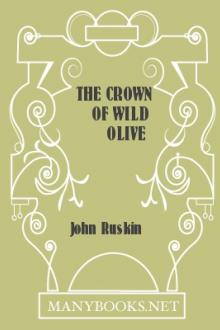Lectures on Landscape by John Ruskin (free ebook reader for android .TXT) 📖

- Author: John Ruskin
- Performer: -
Book online «Lectures on Landscape by John Ruskin (free ebook reader for android .TXT) 📖». Author John Ruskin
So that the defect of color, and substitution of more or less gray or gloomy effects of rounded gradation, constantly express the two characters: first, Academic or Greek fleshliness and solidity as opposed to Gothic imagination; and secondly, of Greek tragic horror and gloom as opposed to Gothic gladness.
43. In the great French room in the Louvre, if you at all remember the general character of the historical pictures, you will instantly recognize, in thinking generally of them, the rounded fleshly and solid character in the drawing, the gray or greenish and brownish color, or defect of color, lurid and moonlight-like, and the gloomy choice of subjects, as the Deluge, the Field of Eylau, the Starvation on the Raft, and the Death of Endymion; always melancholy, and usually horrible.
The more recent pictures of the painter Gérôme unite all these attributes in a singular degree; above all, the fleshliness and materialism which make his studies of the nude, in my judgment, altogether inadmissible into the rank of the fine arts.
44. Now you observe that I never speak of this Greek school but with a certain dread. And yet I have told you that Turner belongs to it, that all the strongest men in times of developed art belong to it; but then, remember, so do all the basest. The learning of the Academy is indeed a splendid accessory to original power, in Velasquez, in Titian, or in Reynolds; but the whole world of art is full of a base learning of the Academy, which, when fools possess, they become a tenfold plague of fools.
And again, a stern and more or less hopeless melancholy necessarily is under-current in the minds of the greatest men of all ages,—of Homer, Aeschylus, Pindar, or Shakespeare. But an earthy, sensual, and weak despondency is the attribute of the lowest mental and bodily disease; and the imbecilities and lassitudes which follow crime, both in nations and individuals, can only find a last stimulus to their own dying sensation in the fascinated contemplation of completer death.
45. Between these—the highest, and these—the basest, you have every variety and combination of strength and of mistake: the mass of foolish persons dividing themselves always between the two oppositely and equally erroneous faiths, that genius may dispense with law, or that law can create genius. Of the two, there is more excuse for, and less danger in the first than in the second mistake. Genius has sometimes done lovely things without knowledge and without discipline. But all the learning of the Academies has never yet drawn so much as one fair face, or ever set two pleasant colors side by side.
46. Now there is one great Northern painter, of whom I have not spoken till now, probably to your surprise, Rubens; whose power is composed of so many elements, and whose character may be illustrated so completely, and with it the various operation of the counter schools, by one of his pictures now open to your study, that I would press you to set aside one of your brightest Easter afternoons for the study of that one picture in the Exhibition of Old Masters, the so-called "Juno and Argus," No. 387.
So-called, I say; for it is not a picture either of Argus or of Juno, but the portrait of a Flemish lady "as Juno" (just as Rubens painted his family picture with his wife "as the Virgin" and himself "as St. George"): and a good anatomical study of a human body as Argus. In the days of Rubens, you must remember, mythology was thought of as a mere empty form of compliment or fable, and the original meaning of it wholly forgotten. Rubens never dreamed that Argus is the night, or that his eyes are stars; but with the absolutely literal and brutal part of his Dutch nature supposes the head of Argus full of real eyes all over, and represents Hebe cutting them out with a bloody knife and putting one into the hand of the goddess, like an unseemly oyster.
That conception of the action, and the loathsome sprawling of the trunk of Argus under the chariot, are the essential contributions of Rubens' own Netherland personality. Then the rest of the treatment he learned from other schools, but adopted with splendid power.
47. First, I think, you ought to be struck by having two large peacocks painted with scarcely any color in them! They are nearly black, or black-green, peacocks. Now you know that Rubens is always spoken of as a great colorist, par excellence a colorist; and would you not have expected that—before all things—the first thing he would have seen in a peacock would have been gold and blue? He sees nothing of the kind. A peacock, to him, is essentially a dark bird; serpent-like in the writhing of the neck, cloud-like in the toss and wave of its plumes. He has dashed out the filaments of every feather with magnificent drawing; he has not given you one bright gleam of green or purple in all the two birds.
Well, the reason of that is that Rubens is not par excellence a colorist; nay, is not even a good colorist. He is a very second-rate and coarse colorist; and therefore his color catches the lower public, and gets talked about. But he is par excellence a splendid draughtsman of the Greek school; and no one else, except Tintoret, could have drawn with the same ease either the muscles of the dead body or the plumes of the birds.
48. Farther, that he never became a great colorist does not mean that he could not, had he chosen. He was warped from color by his lower Greek instincts, by his animal delight in coarse and violent forms and scenes—in fighting, in hunting, and in torments of martyrdom and of hell: but he had the higher gift in him, if the flesh had not subdued it. There is one part of this picture which he learned how to do at Venice, the Iris, with the golden hair, in the chariot behind Juno. In her he has put out his full power, under the teaching of Veronese and Titian; and he has all the splendid Northern-Gothic, Reynolds or Gainsborough play of feature with Venetian color. Scarcely anything more beautiful than that head, or more masterly than the composition of it, with the inlaid pattern of Juno's robe below, exists in the art of any country. Si sic omnia!—but I know nothing else equal to it throughout the entire works of Rubens.
49. See, then, how the picture divides itself. In the fleshly baseness, brutality and stupidity of its main conception, is the Dutch part of it; that is Rubens' own. In the noble drawing of the dead body and of the birds you have the Phidias-Greek part of it, brought down to Rubens through Michael Angelo. In the embroidery of Juno's robe you have the Dædalus-Greek part of it, brought down to Rubens through Veronese. In the head of Iris you have the pure Northern-Gothic part of it, brought down to Rubens through Giorgione and Titian.
50. Now, though—even if we had given ten minutes of digression—the lessons in this picture would have been well worth it, I have not, in taking you to it, gone out of my own way. There is a special point for us to observe in those dark peacocks. If you look at the notes on the Venetian pictures in the end of my "Stones of Venice," you will find it especially dwelt upon as singular that Tintoret, in his picture of "The Nativity," has a peacock without any color in it. And the reason of it is also that Tintoret belongs, with the full half of his mind, as Rubens does, to the Greek school. But the two men reach the same point by opposite paths. Tintoret begins with what Venice taught him, and adopted what Athens could teach: but Rubens begins with Athens, and adopts from Venice. Now if you will look back to my fifth Lecture[9] you will find it said that the colorists can always adopt as much chiaroscuro as suits them, and so become perfect; but the chiaroscurists cannot, on their part, adopt color, except partially. And accordingly, whenever Tintoret chooses, he can laugh Rubens to scorn in management of light and shade; but Rubens only here and there—as far as I know myself, only this once—touches Tintoret or Giorgione in color.
51. But now observe farther. The Greek chiaroscuro, I have just told you, is by one body of men pursued academically, as a means of expressing form; by another, tragically, as a mystery of light and shade, corresponding to—and forming part of—the joy and sorrow of life. You may, of course, find the two purposes mingled: but pure formal chiaroscuro—Marc Antonio's and Leonardo's—is inconsistent with color, and though it is thoroughly necessary as an exercise, it is only as a correcting and guarding one, never as a basis of art.
52. Let me be sure, now, that you thoroughly understand the relation of formal shade to color. Here is an egg; here, a green cluster of leaves; here, a bunch of black grapes. In formal chiaroscuro, all these are to be considered as white, and drawn as if they were carved in marble. In the engraving of "Melancholy," what I meant by telling you it was in formal chiaroscuro was that the ball is white, the leaves are white, the dress is white; you can't tell what color any of these stand for. On the contrary, to a colorist the first question about everything is its color. Is this a white thing, a green thing, or a blue thing? down must go my touch of white, green, or dark blue first of all; if afterwards I can make them look round, or like fruit and leaves, it's all very well; but if I can't, blue or green they at least shall be.
53. Now here you have exactly the thing done by the two masters we are speaking of. Here is a copy of Turner's vignette of "Martigny." This is wholly a design of the colored school. Here is a bit of vine in the foreground with purple grapes; the grapes, so far from being drawn as round, are struck in with angular flat spots; but they are vividly purple spots, their whole vitality and use in the design is in their Tyrian nature. Here, on the contrary, is Dürer's "Flight into Egypt," with grapes and palm fruit above. Both are white; but both engraved so as to look thoroughly round.
54. All the other great chiaroscurists whom I named to you—Reynolds, Velasquez, and Titian—approached their shadow also on the safe side—from Venice: they always think of color first. But Turner had to work his way out of the dark Greek school up to Venice; he always thinks of his shadow first; and it held him in some degree fatally to the end. Those pictures which you all laughed at were not what you fancied, mad endeavors for color; they were agonizing Greek efforts to get light. He could have got color easily enough if he had rested in that; which I will show you





Comments (0)